

Lots of dyeing - Ruby Slippers. Whenever I eat an avocado I wash and dry the pit and put it in a plastic bag in the freezer.
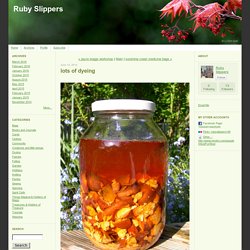
Recently I took out some of my pits, thawed them, put them in a thick plastic bag and smashed them with a mallet. I soaked them in a large jar for 10 days, stirring daily. The liquid started out a clear orangey red as shown in the photo but gradually turned to a cloudy apricot colour. I cooked the pits for a couple of hours and then let them soak overnight before adding the fibre. I heated the dyebath to just below a simmer, held it there for an hour and then let everthing cool in the dyebath overnight. Shiborihulluus - Outi Les Pyy Outi Les Pyy. Jokaisella tekstiili- ja vaatesuunnittelijalla tuntuu olevan aika, jolloin hän hurahtaa japanilaiseen tekstiilitaiteeseen.
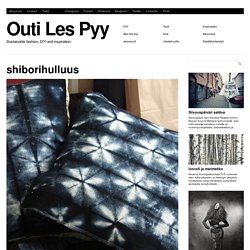
Kuten Kiinassa, myös Japanissa on tuhansia vuosia vanha tekstiili- ja käsityökulttuuri, josta ammentaa inspiraatiota sadoilla eri tekniikoilla. Minusta tuntuu, että oma japanikauteni on tulossa kovaa vauhtia. Caroline Kampfraath in Freundinnen in het Frauenmuseum, Bonn - NN : Expositie / Exhibition at GALERIES.NL. Rupsvriendelijke jurk met ananaspump. Natural Dyes - About The Organic Indigo Vat - the MAIWA BLOG. The Maiwa Guide to Natural DyesWhat they are and how to use them These organic vats were originally developed by French dye chemist and botanist, Michel Garcia.
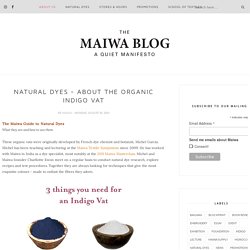
Michel has been teaching and lecturing at the Maiwa Textile Symposium since 2009. He has worked with Maiwa in India as a dye specialist, most notably at the 2011 Maiwa Masterclass. Michel and Maiwa founder Charllotte Kwon meet on a regular basis to conduct natural dye research, explore recipes and test procedures. Together they are always looking for techniques that give the most exquisite colours - made to outlast the fibres they adorn. From Your Kitchen to Your Studio: At Home Botanical Dyes. Our first natural dye tutorial focused on extracting cochineal dye purchased from a supplier.
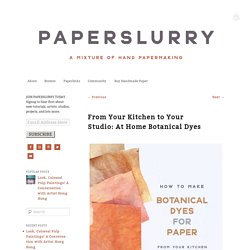
Whether you’re new to naturally dyeing handmade paper or looking to expand your color range, potential dyestuff might live closer than you think—you can extract dyes from items found in your kitchen. Keep reading to learn about more ways to experiment with natural dyes and handmade paper! When using edible plants for papermaking and natural dyeing, rather than selecting the edible part of the plant, it is best to turn to the skins, stalks, or husks of plants. For papermaking, the strongest paper will come from non-edible elements of plants (leaves, bast fibers, grasses) because of their high cellulose content. Corn stalks, for example, yield a strong, high shrinkage decorative paper.
De wereld van Kina @dewereldvankina Instagram Profile. Plastic van suikerriet mag in de gft-bak. Filters met minuscule gaatjes voor plastic deeltjes kleiner dan een zandkorrel. Weg met plastic in laagjes: dat is niet te recyclen. Verf of inkt maken. Het maken van natuurlijke verf of inkt gebeurt in twee stappen: Eerst moet de verfstof, bestaande uit kleurstoffen of pigmenten uit de plant worden gewonnen.
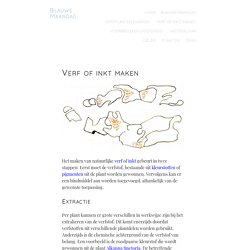
Arabische gom ruw - Hekserij : Hekserij. Microbiology at Home: A short non-laboratory manual for enthusiasts and bioartists. Exploring The Invisible. C-MOULD, the world’s largest collection of microorganisms for use in the arts, with over 50 different kinds of microorganism.
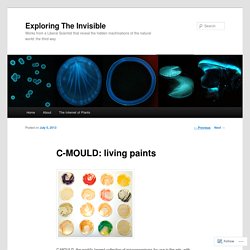
We have bacteria and fungi that glow in ethereal shades of green and blue light, bacteria that make gold and electrically conductive nanowires, and bacteria that produce biotextiles. Jannis hülsen: cellulose fibre xylinum stool. Bioplastic Making. MYX. Dutch designers convert algae into bioplastic for 3D printing. Dutch designers Eric Klarenbeek and Maartje Dros have developed a bioplastic made from algae, which they believe could completely replace synthetic plastics over time.

Klarenbeek and Dros cultivate algae – aquatic plants – which they then dry and process into a material that can be used to 3D print objects. The designers believe that the algae polymer could be used to make everything from shampoo bottles to tableware or rubbish bins, eventually entirely replacing plastics made from fossil fuels like oil. They are among a host of designers using algae to create products that are more environmentally friendly than their synthetic counterparts, from fabric dyes and water bottles to chairs and even entire building facades.
As well as algae, Klarenbeek and Dros have created biopolymers from other organic raw materials such as mycelium, potato starch and cocoa bean shells, which they use to 3D print objects. Agar Plasticity plastic alternative « Inhabitat – Green Design, Innovation, Architecture, Green Building. Winners of $1 million prize to develop plastic alternatives announced. The winners of a lucrative competition tasking designers to come up with new materials to replace plastic packaging have been revealed.

Announced at the World Economic Forum Annual Meeting in Davos, the Circular Materials Challenge winners aim to develop alternatives for the plastic packaging materials that are currently used for sauces, fresh coffee, and snacks – which are currently too hard or expensive to recycle. The five winners will each receive a $200,000 share of the $1 million prize and will join a 12-month accelerator programme, run in collaboration with Think Beyond Plastic, to make the innovations marketable at scale. The challenge forms part of the Ellen MacArthur Foundation's Plastics Economy Innovation Prize, which aims to dramatically reduce the number of plastics that enter the ocean each year by encouraging innovation to prevent the materfrom becoming waste in the first place.
Read on for the five winners. University of Pittsburgh Aronax Technologies Spain. Using Oysters to Compost Plastics (fungi forum at permies) I am currently writing a paper in conjunction with my experiment to develop a strain of oysters to eat through the incomprehensible amount of plastic we see these days.

If anybody else is interested, I am planning to do the following: Set up an Inoculation Chamber where I will inoculate live cultures of Oyster Mushrooms (Pleuroteus Djamor) into agar media inside petri dishes. I will isolate the best rhizomorphic patterns to transfer a wedge of the media to another dish until I get a strain that grows rapidly. I will then transfer the best strain to a substrate medium and use various amounts of plastics shredded into the jars with woodchips.
Oil production with polymer flooding. Learning from nature is worthwhile and it is often how researchers develop solutions response to technical challenges.

One well-known example is the lotus effect, where water and dirt are repelled on certain surfaces - a phenomenon that can be observed on the leaves of lotus flowers and is today exploited, for instance, in the production of washbasins. Wintershall has understood that you can make use of nature for technical innovations. The company is currently developing an environmentally friendly technology that could significantly raise the recovery rate of reservoirs - and nature is playing the key role in this process. Dead tree – new life. Yeast and Malt Extract with Glucose Media Recipe. Limonene. 3 Ways to Extract Oil from Orange Peels. Reader Approved Three Methods:Making Orange Essential Oil in a JarInfusing Oil with OrangeUsing Orange Essential OilCommunity Q&A The oil extracted from oranges is used in a number of cleaning products and food recipes because of its pleasant aroma and powerful solvent properties. It is also believed to possess a number of health benefits.
Mushroom Dyes at Taos Wool Festival-2010. Sinaasappelolie. Citrus sinensis (L.) Alocasia macrorrhizos (giant taro) Datasheet Don't need the entire report? Generate a print friendly version containing only the sections you need. Generate report Pictures. Pinterest. Starch. Starch or amylum is a polymeric carbohydrate consisting of a large number of glucose units joined by glycosidic bonds. This polysaccharide is produced by most green plants as energy storage. It is the most common carbohydrate in human diets and is contained in large amounts in staple foods like potatoes, wheat, maize (corn), rice, and cassava. Pure starch is a white, tasteless and odorless powder that is insoluble in cold water or alcohol. It consists of two types of molecules: the linear and helical amylose and the branched amylopectin. Depending on the plant, starch generally contains 20 to 25% amylose and 75 to 80% amylopectin by weight.[4] Glycogen, the glucose store of animals, is a more highly branched version of amylopectin.
Extracting Starch from Potatoes. Make your own algae bioplastic. Our recent news article about algae as a source for bioplastic has received a lot of attention. But there is something very important that it didn’t tell you: You can make your own bioplastic from algae. And we will give you step-by-step instructions on how to do it. It’s a fun little science project. You can do it in your kitchen, with stuff you buy at the grocery store.
First, a little background. A recipe for vegan bioplastic? In a comment to our article Home-made bioplastic sword! , Larry asks this: Verftechnieken. Schellak is zo’n veelzijdig en super handig product dat een beetje serieuze schilder of meubeltpimper het naar mijn mening écht in huis moet hebben.Schellak is handig, veelzijdig, sneldrogend, milieuvriendelijk, volkomen veilig, niet giftig, biologisch afbreekbaar, (dus heel kindvriendelijk) gemakkelijk in gebruik en werkt verbluffend goed bij allerlei verfklusjes. FAQ – materiability. Bioplastic from banana peels. GROWING PRODUCTS - Growing experimentation[[MORE]] I started growing... Orange Peel Fungus. Reproduction: The Orange Peel Fungus Way... Aleuria aurantia exhibits both sexual and asexual reproduction.
In the Orange Peel Fungus, the entire sexual reproductive process takes place within the asci. Sexual Reproduction To initiate the reproductive cycle in the Orange Peel Fungus, mitosis originally occurs in the hyphae, which leads to the development of the asci. Because components of the ascocarp are male (antheridia) or female (ascogonium), nuclei from these types of cells can fuse together when hyphae of the two cell types come into contact; this process is known as karyogamy. After the fusion of the two nuclei, meiosis, or the sexual part of the cycle, occurs. Asexual Reproduction.
Schellak. Schellak. Schellak. What polymers can I use? In a comment on one of our articles, student Maya asks question: For my science experiment I’ve now decided to substitute the polymers in the bioplastic recipe. I wanted to use chitin, and lignin and corn starch. But both lignin and chitin are really hard to find. Q&A: Can I make waterproof bioplastic? PIEL VIVO/ BIO-PLASTICA – Material Explorations – IAAC Blog. “More than a substance, plastic is the very idea of its infinite transformation; as its everyday name indicates, it is ubiquity made visible. Bioplastic from banana peels.
The Shapeshifter: material innovation FluidSolids. How to Grow Luffas - Little Sprouts Learning. I’ll tell you how in just a few short steps. Orange Peel Glands. Orange Peel Fungus. How To Grow Mushrooms on Straw. Movie: Eindhoven design studio Formafantasma experimenting with lava. 3 Ways to Make Bioplastic Easily. Marcin Rusak Interview - News - Frameweb. How to Make a DIY Silicone Mould. 5 Unexpected Natural Sources of Dye – Rubina Magazine. Bio-Plastic Morphologies – materiability. How to Distill Essential Oils. Rate of Photosynthesis. Demonstration: Fluorescence of Chlorophyll. About – Angelique van der Valk.
The Journey towards Invisible Resources... — Zuzana GomboSova. GROWING PRODUCTS - Growing experimentation[[MORE]] I started growing... Sodium Alginate (alginate, algin) 041a - Agars for Microbiology Media and Other Uses. Additives : Sodium alginate. Alginic acid - Wikipedia. Agar - Wikipedia. DM - Elastic Impression Material Flashcards. Neri Oxman Is Redesigning the Natural World - SURFACE. GROWING PRODUCTS - Growing experimentation[[MORE]] I started growing... Making Paper from Seaweed: Papermaking with Atlantic BioInvader Codium Fragile. Make Your Own Paper from Plants. Chronique d’une makeuse en matériaux (23) Skill of the Month: Making Black Walnut Dye. Natural dyes: their history and how to make them. Works Archive - Lorenzo Oggiano. Tutorials « materiability research network. Plastic made from orange peel and CO2 - Advanced Science News.
16-year-old South African girl invents drought-fighting super material from orange peels. Orange is the new black gold: how peel could replace crude oil in plastics. A fruitful idea: fabric made from orange peel by Orange Fiber. Eeuw geleden werd eerste vrouw professor - NRC. Artists Materials - Pigments from the Earth: Part 1 - Natural Pigments. Pigge weet raad met natriumbicarbonaat - drogisterij A.J. van der Pigge. A Fresh Perspective on the Psychology of Scent. The Illustrated Bead Bible: Terms, Tips & Techniques - Theresa Flores Geary, Debra Whalen.
Verf of inkt maken. Galnoteninkt: ingrediënten, recept & Rietpennen, rietpen, ganzenveer, galnoten, galnoot, bistre. Kweken. 40. Zelf oesterzwammen kweken. DIY BioPrinter. Korstmos. The Color Atlas. Wednes-DIY: Making Natural Dyes. Building with Seawater in the Desert. Research - ingridnijhoff. Portfolio september, Maayan Pesach by mayap10. Micropia - Micropia. Microbial cellulose - Wikipedia.
773.